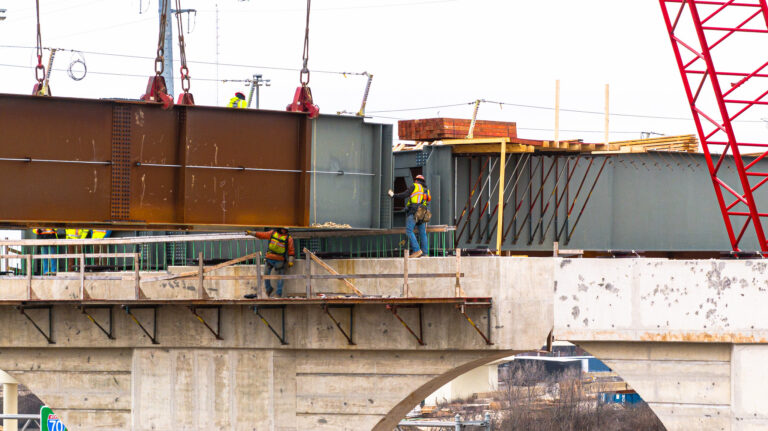COLUMBUS, Ohio – Governor Mike DeWine and the Ohio Department of Transportation (ODOT) have released the results of an 18-month study looking at transportation investments to support economic growth and development in the state.
“The goal is to help us understand how Ohio’s highways influence and support statewide economic growth and prioritize transportation projects, as funding is available,” Governor DeWine said. “Ohio’s economy is growing and to keep this momentum going, we must get people to work and deliver goods on time.”
18-Month Effort
For more than a year, ODOT has worked with the Governor’s Office of Workforce Transformation, the Ohio Department of Development, JobsOhio, and more than 500 elected officials, business leaders, and transportation and regional planning experts to identify needs, opportunities, and concerns. Staff from ODOT’s 12 districts also shared their local expertise.
Ohio ranks 6th in the nation in terms of freight volume with nearly 1.4 billion tons of freight moving to, from, and through the state annually. Ohio-based businesses can access more than 60% of the U.S. and Canadian population within a one-day drive. The state’s multimodal transportation system, which includes highways, rail corridors, airports, transit systems, and marine ports, lead the nation by many measures. This system supports the industries and the workforce that drive the state’s economy.
Planning Tool
“Overall, most of Ohio’s major highway corridors are handling the needs of today and are expected to do so in the future, even if current population and economic growth trends accelerate,” said Pamela Boratyn, ODOT director. “However, we have identified congestion risks that could hinder future economic development. This tool will assist ODOT and local leaders in ensuring transportation is never a roadblock to economic opportunity.”
In just the past five years, Ohio has seen major investments from companies like Intel, Amazon, Google, Meta, Honda, PharmaVite, Anduril Industries, Joby, and many others. These companies are choosing Ohio due to workforce, location, and quality of life. However, each of these things rely on a strong transportation system.
In 2023, Ohio’s gross domestic product (GDP) was $872.7 billion, the seventh highest in the nation. Six of Ohio’s metropolitan statistical areas ranked in the top 100 in the nation for GDP. Cincinnati, Columbus, and Cleveland are in the top 40.
What the Study Found
The report identifies 72 congestion risk locations across the state, referred to as “hotspots.” All were considered in the context of Ohio’s economic goals and ODOT’s broader mission to provide a transportation system that is safe, accessible, well-maintained, and positioned for the future.
Of the 72 congestion risk locations, all but 21 were already on ODOT’s radar. The 51 projects already in the ODOT pipeline represent a total investment of $13 billion. However, $6.1 billion worth of the projects remain unfunded. There is no funding source identified for the other 21 projects the study recommends.
Six Corridor Focus
ODOT analyzed risks associated with congestion in seven geographic/economic regions and studied interregional connections along six focus corridors. These corridors included Toledo to Columbus and Sandusky to Columbus, as specified in Ohio House Bill 23. They specifically examined how these corridors will meet travel needs over the next 10, 20, and 30 years.
Toledo – Columbus
This corridor includes I-75, US 68, State Route 31, and US 23. It connects Northwest Ohio, including Toledo, with Central Ohio’s fast-growing Delaware and Union counties. It is also a critical link to Detroit and US-Canada border crossings from Central Ohio, including the Gordie Howe International Bridge, which is expected to open later this year. The study confirmed the need to make significant improvements to the throughfares that connect Columbus and Toledo.
Population is expected to grow south along I-75 in Toledo’s suburbs and in Bowling Green and Findlay. Continued growth is also expected in Delaware, Marysville, and northern Columbus suburbs. There are significant, existing congestion issues in that area, particularly along US 23 in Delaware County, and other areas are nearing capacity. Future congestion risks are expected to expand unless addressed.
The corridor has a mix of full, partial, and no access control with almost 2,000 private driveways and over 400 at-grade intersections. These conflict points can lead to crashes and congestion, which degrade the safety and reliability of the travel route. This corridor contains 20% of the top segments identified in the state’s Highway Safety Improvement Program (HSIP) which funds infrastructure improvements to prevent serious injuries and traffic deaths on Ohio roads.
The priority recommendation is to improve US 23 between Waldo and I-270. However, the study does not recommend construction of an alternative freeway due to the cost as well as minimal travel time reductions from such an alternative freeway.
Sandusky – Columbus
This corridor includes SR 4, US 250, I-71, and US 23. It connects Sandusky and resort areas along Lake Erie with communities in Delaware and Franklin counties. Sandusky’s economy relies on tourism and manufacturing while the Delaware County economy is expected to continue to diversify.
Population growth along the corridor has been mixed. The Port of Sandusky and proximity to I-90 provide growth opportunities for logistics-related businesses. Population is forecasted to continue declining in rural areas between Sandusky and Marion. Delaware and northern Columbus suburbs will continue to grow and generate strong travel demand on the corridor. Several corridor segments are experiencing congestion while others are nearing capacity. US 23 and I-71 between US 36 and I-270 have the highest number of future congestion risks.
Approximately 50% of the mileage along the corridor has no access control and numerous driveways. These conflict points can lead to crashes and congestion, which degrade the safety and reliability of the travel route. The corridor includes over 20% of the state’s top 100 highway safety improvement locations with priority segments along I-71.
The study recommended evaluating potential improvements to SR 4 and US 250 to address constraints through city and town centers such as Bucyrus and Norwalk. Improvements could include widening narrow shoulders and adding turn lanes in rural areas.
Columbus – Kentucky/West Virginia
This corridor includes US 23 and US 52 and connects Central Ohio with Southeast Ohio, Portsmouth, the Ohio River, West Virginia, and Kentucky. Grove City and the southeastern segments of I-270 have attracted a workforce searching for affordable housing. Bedroom communities are anticipated to continue to develop along US 23 south toward Circleville as well as in Grove City and the southeastern segment of the Columbus I-270 outer belt.
Rickenbacker International Airport has spurred strong logistics-related businesses nearby, resulting in significant growth in employment and truck trips. Ross County and areas further south are expected to decline in population but there are pockets of development and manufacturing opportunities north of Chillicothe. Portsmouth has experienced population and employment declines, but increases in development are expected.
There are multiple roadway segments nearing capacity. Access control varies significantly along US 23 and US 52. Dense commercial driveway spacing and numerous residential driveways can lead to crashes and congestion risks, which degrade the safety and reliability of the travel route.
The priority recommendation is to initiate a feasibility analysis and initial project development activities that will position ODOT to increase capacity and manage access on US 23 from I-270 to south of Circleville.
Columbus-West Virginia
The US 33 corridor connects Central Ohio with Southeast Ohio, the Ohio River, and West Virginia. It also connects Columbus and its southeast suburbs of Groveport and Canal Winchester and travels along the south edge of Pickerington. This segment of US 33 is a four-lane highway with partial access control.
Strong economic growth in Columbus and the southeast suburbs of Franklin County is expected to continue. Groveport, Canal Winchester, and Pickerington have experienced strong population and employment growth over the last 20 years. Rickenbacker International Airport, which can be accessed from US 33, is a major employer and truck trip generator.
Athens has experienced modest population growth over the last 20 to 30 years. US 33 is a key gateway for tourism destinations, while population and employment in Ohio River communities have declined over the last several decades.
Congestion is concentrated at the northern end of the corridor on US 33 from the I-270 interchange to SR 317. US 33 is nearing capacity almost entirely from SR 317 through Groveport and Canal Winchester to the US 33 Business Route branch in Fairfield County. Access varies between partial and full control, which can lead to crashes and congestion and degrade the safety and reliability of the travel route. The corridor has 29 safety improvement locations.
It also recommended seeking construction funding for existing ODOT projects on US 33 in Franklin and Fairfield counties.
Cincinnati-Dayton
The I-75 corridor connects Dayton and Cincinnati. The north end of the corridor is near Dayton International Airport and Union Global Logistics Airpark at Dayton Airport, with many logistics-related businesses located nearby. To the east of the corridor, with access from I-675, Wright-Patterson Air Force Base is a major military installation focusing on logistics. The corridor includes large, fast-growing suburbs as well as large manufacturing employers.
Major employers and logistics-related businesses are located in downtown Cincinnati and at the Port of Cincinnati-Northern Kentucky, which recently expanded and is now the largest inland port in the country.
I-75 currently is experiencing congestion on several segments. In the future, the highest congestion risks are on I-75 near the I-275 interchange north of Cincinnati and from SR 73 north through downtown Dayton.
Interchanges are adequately spaced and have signalized intersections, except the northbound entrance ramp from Stewart Street. The segments with the most safety concerns are primarily near system interchanges and in downtown Dayton.
The corridor has 12 priority segments and nine priority intersections in the highway safety program’s top 100 locations.
The study recommended continuing to develop projects associated with the I-75/I-275 interchange and work with regional planning organizations to improve Cincinnati to Dayton corridor connections.
Canton/Youngstown-West Virginia/Pennsylvania
This corridor includes US 30 and SR 11 and connects Northeast Ohio with West Virginia and the Pittsburgh metropolitan area in Pennsylvania.
Canton and Youngstown have experienced population and employment declines in their urban cores. However, Canton has recorded population growth in some northern areas, while Youngstown has observed growth in its southwestern suburbs.
Employment trends have fluctuated, with significant job losses in higher-paying manufacturing industries. In East Canton, US 30 features rural areas with existing warehousing and logistics businesses. Austintown Township has shown population and employment growth trends. US 224 provides connectivity to SR 11 and I-680, facilitating regional movement. I-680 and I-76 enhance network connectivity and access to logistics and warehousing industries.
The corridor includes a mix of roadway types. The western portion lacks access control, consisting primarily of a two-lane roadway with sections that expand to three lanes near villages or for truck climbing lanes. The eastern portion is a four-lane, fully access-controlled interstate highway with 10 interchanges.
No corridor segments are experiencing congestion currently, and traffic volumes are generally well below roadway capacity. Safety concerns have been identified along US 30 between East Canton and Minerva and on SR 11 from the I-80 interchange to the US 224 interchange, which records the highest crash frequency on the corridor.
The study recommended addressing local safety concerns and updating interchanges on US 30 in Stark and Columbiana counties.
The full report, including appendices, and a digital interactive mapping tool can be found at transportation.ohio.gov/statewidestudy






